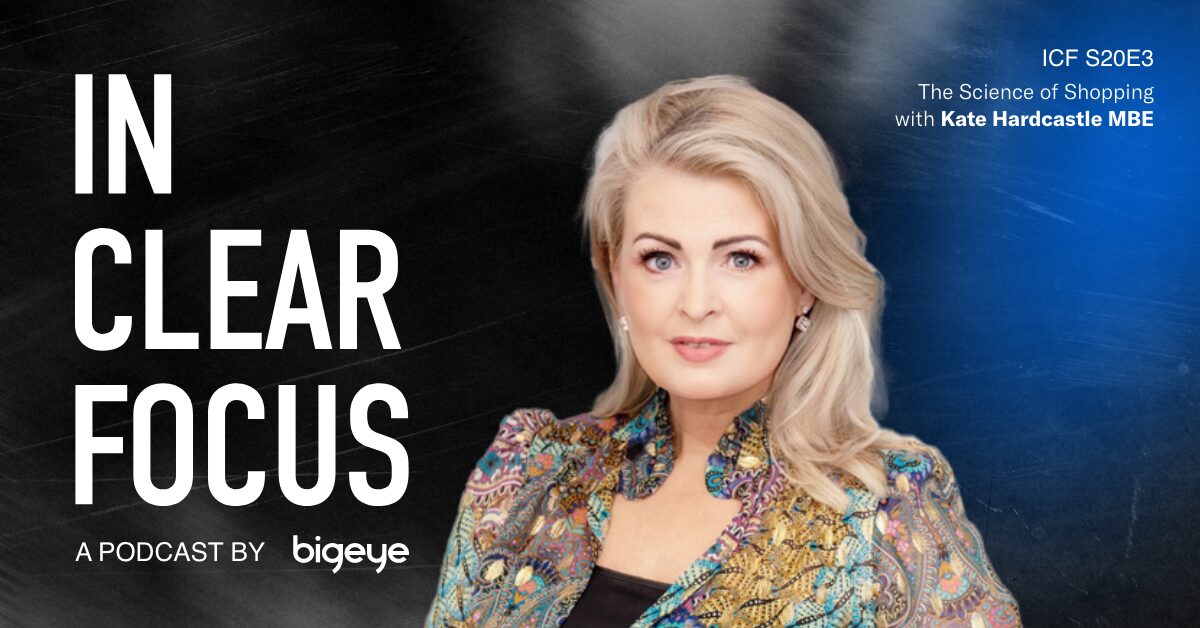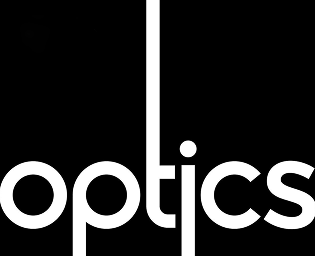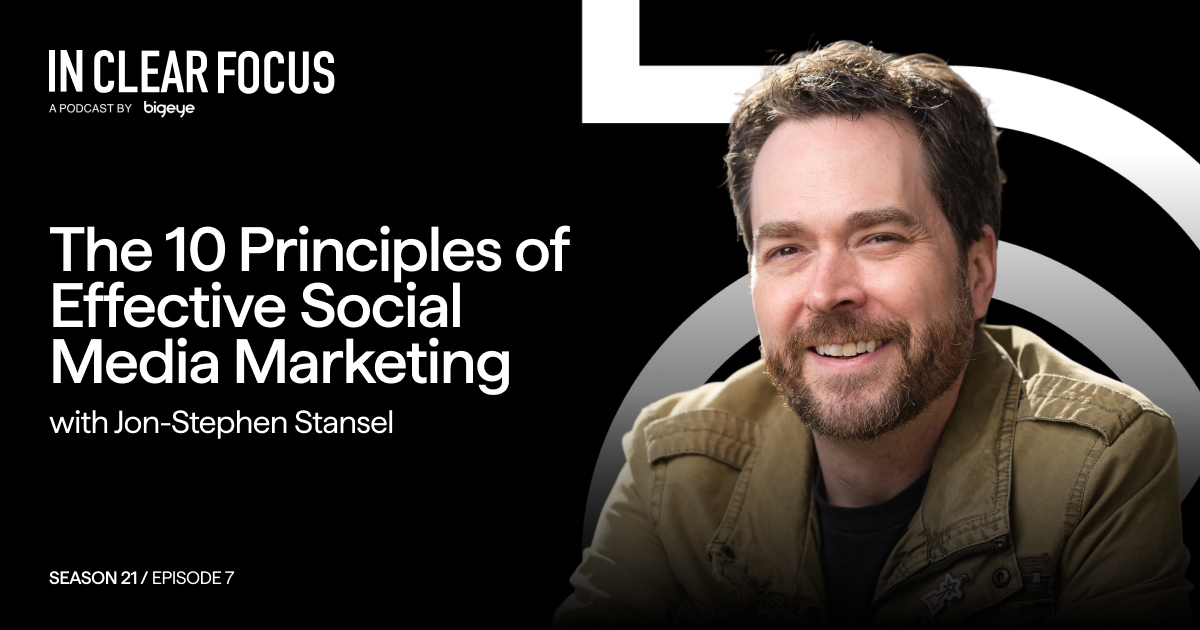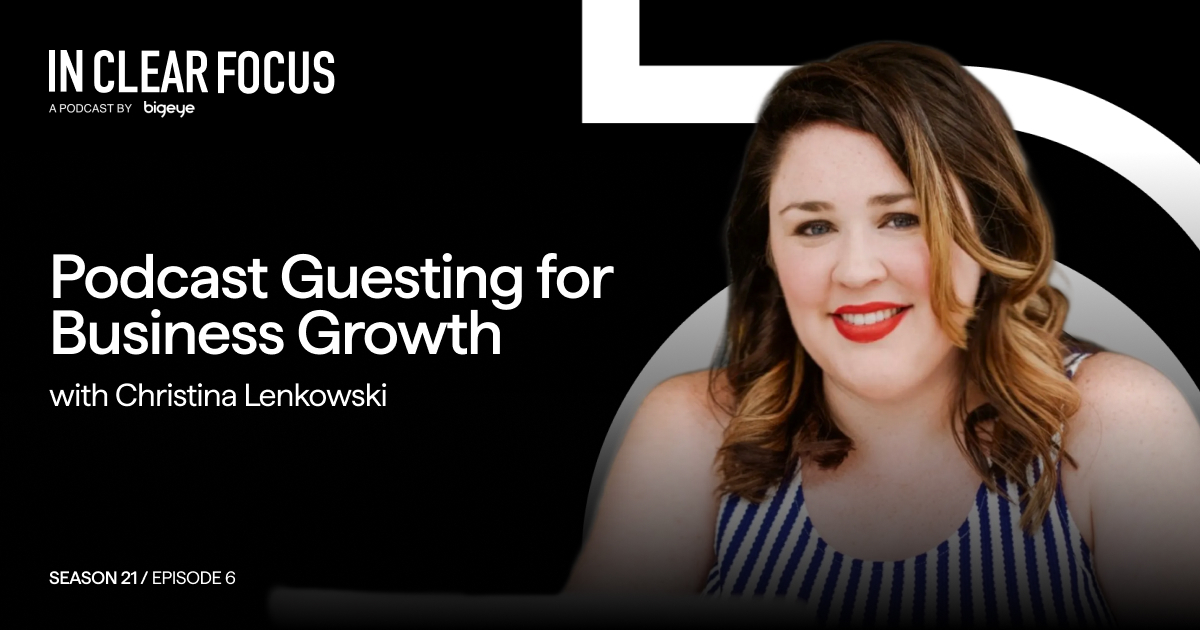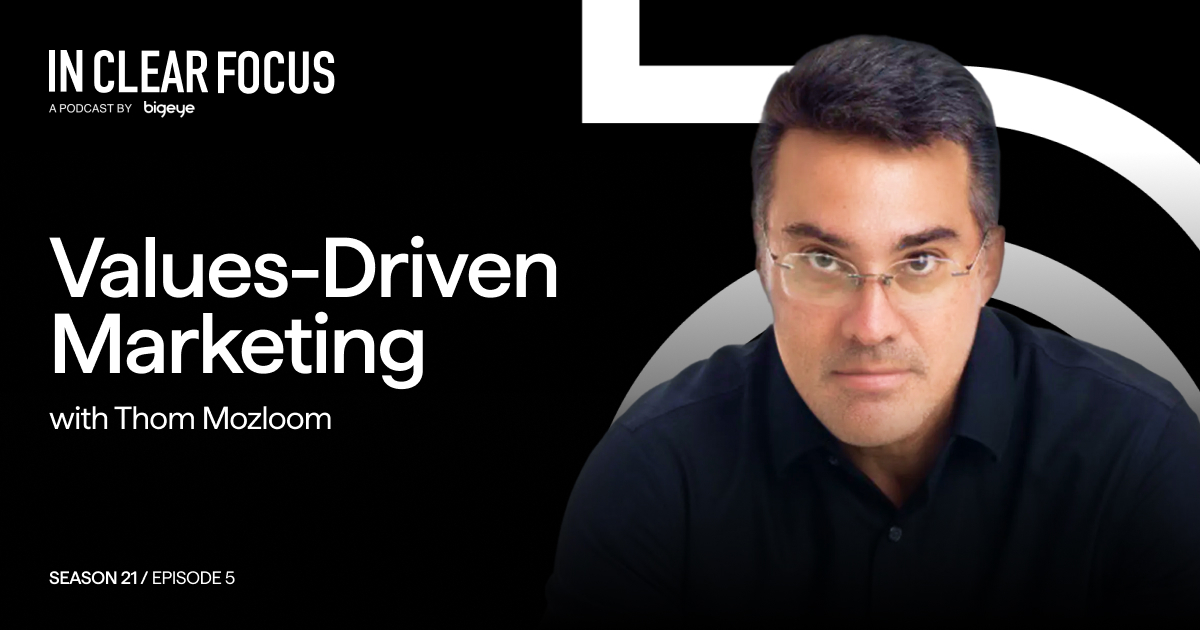IN CLEAR FOCUS: Kate Hardcastle MBE, aka “The Customer Whisperer,” is the author of “The Science of Shopping,” exploring how consumer psychology and innovation are reshaping retail. Kate discusses “The Buyerarchy of Needs,” emotional drivers, digital transformation, personalization, and the theatrical evolution of brick-and-mortar stores. Learn key pricing strategies and the biggest mistakes brands make in consumer engagement, emphasizing the importance of listening and building authentic trust.
Episode Transcript
Adrian Tennant: Coming up in this episode of IN CLEAR FOCUS.
Kate Hardcastle MBE: It’s a rebirth of retail, and what we’re seeing is this human contact, this spontaneity, this community, and this opportunity to story tell on a deeper brand level is coming to life; suddenly that’s not a store anymore, that’s a social activity.
Adrian Tennant: You’re listening to IN CLEAR FOCUS, fresh perspectives on marketing and advertising produced weekly by Bigeye, a strategy-led full-service creative agency, growing brands for clients globally. Hello, I’m your host, Adrian Tennant, Bigeye’s Chief Strategy Officer. Thank you for joining us. Today, shopping is often a multi-sensory experience that blends psychology, technology, and emotion. Whether browsing online or walking through a physical store, every touchpoint is an opportunity for brands to connect, engage, and ultimately influence purchasing decisions. Understanding the science behind these shopping behaviors has become crucial for brands seeking to thrive in an increasingly competitive retail marketplace. From the psychological triggers that drive impulse purchases to the digital innovations reshaping e-commerce, successful retailers are those who can decode the complex motivations behind consumer behavior and translate those insights into compelling experiences. Our guest today is uniquely positioned to guide us through this intersection of psychology and retail strategy. Kate Hardcastle, MBE, is a highly respected business consultant and international authority on consumer insight and business transformation. Known as the customer whisperer, she’s spent over 25 years decoding consumer behavior and helping develop effective strategies for some of the world’s most recognizable brands, including Disney, Marks & Spencer, and American Express. Kate was awarded an MBE by Queen Elizabeth II in 2018 for her services to business and entrepreneurship. Today, Kate is a sought-after keynote speaker at events worldwide, including Cannes Lions and South by Southwest, and her insights have been featured across leading media outlets such as the BBC, CNN, and Forbes. Her new book, published by Kogan Page, is “The Science of Shopping: How Psychology and Innovation Create a Winning Retail Strategy.” To discuss the psychological and technological forces shaping modern retail, I’m delighted that Kate is joining us today from Oxford, England. Kate, welcome to IN CLEAR FOCUS.
Kate Hardcastle MBE: Thank you so much for having me, Adrian. It’s a pleasure.
Adrian Tennant:So, Kate, what inspired you to write “The Science of Shopping“?
Kate Hardcastle MBE:Very honestly, I am so fortunate to have a unique perspective on it. So from loading vans with courier companies at dawn and being able to go and deliver parcels as part of a unique customer insight experience piece that I did, through to advising those boardrooms with some of the most beloved organizations, it was an opportunity for me to put pen to paper and really create that culmination of everything I’ve learned. Because sometimes we have retail specialists that will focus very much on what happens just in the store, or these days, online. And we know that the channel of communication and the channel of being able to buy is just growing all of the time. So with that being the case, I wanted something that really started to demystify the psychological element, which is the starting point for me. What’s even in your mind as a consumer when you begin to shop and create something that could serve the customer, the retail, the brands that serve the retail, and even the logistics organizations. So we could all understand on this journey for businesses, large and small, what’s guiding the consumer, and therefore how do we go past the idea that it’s just buying stuff into something that’s actually truly a representation, I hope, of the emotion behind why people shop, why everyone shops, and what organizations need to do to appeal better to that.
Adrian Tennant: Well, in your book, you introduce something called ‘The Buyerarchy of Needs.’ Can you explain what this is and how it differs from traditional models of consumer behavior?
Kate Hardcastle MBE:Buyerarchy is very similar-sounding to hierarchy and ‘Hierarchy of Needs,’ of course, it’s Maslow’s great theory, and it’s stolen with pride, shall we say, from that theory. It’s a model reflecting how shopping decisions are made today are very fluid and transient. And this just speaks to the very frangible people we are that we could maybe watch an environmental documentary and suddenly be reminded of all the things we should purposely do as consumers to ensure that we are leaving the planet in a better place, or at least in a place for the next generation. But then we could take a look at our bank balance on an app seconds later and be reminded of our own needs as that becomes maybe a bit of a bleaker picture than we expected, and decide that we must be much more value-oriented when it comes to shopping. So all of this is almost this movable piece and the book explains how at the base, you’ve got kind of survival, affordability, but then the experience, the expression, the community are all layers upon this. And the thing I would highlight is that it moves all of the time, it’s persuaded either by our peer group or each other or, as I say, something we might have just seen on social media on the television So it’s not just shopping to buy, we’re shopping to belong, we’re shopping to express, we’re shopping to influence, and this helps to talk to that. And I’ve created a case study to make it very simple. So we’ve got Matt in the book who’s buying a coffee machine, which you think would be pretty simple, but actually, we take you through all of the different inflections and things that Matt feels and goes through just to buy that purchase. And when you actually take it down, and write piece-by-piece, and all of the theories and things that will be existing consciously and subconsciously, I think it’s fascinating.
Adrian Tennant: I love the consumer journey part of it. It’s a great example. Now, you argue that shopping fulfills deep emotional and social needs, extending beyond the mere acquisition of products. So, Kate, what are some of those psychological drivers that brands should understand?
Kate Hardcastle MBE: Yeah, you’re absolutely right. And of course, it does sound a bit deep and meaningful, but bear with us. I’ve tried to kind of make it easy to understand by probably these recurring drivers, definitely the reassurance piece. So trusting the price or the product or the brand or the process, the retail themselves, where does that reassurance come? That validation piece, so that could be everything from I’m confident as myself as a consumer that I feel validated in this purchase, or indeed we’re seeking external validation because we want our peer-to-peer recognition. We might even want to brag on social media that we’ve bought a certain brand or something. Then there’s the discovery element of it. Now, discovery is really important in this day and age because it’s so much easier to browse. We can pretty much put in “red balloon statue with clown” and something will come up on the internet. You know, that wasn’t the case when we started the shopping journey, personally for me, several years ago. So how now discovery is much more of an excitable element, things you’ve not seen yet you don’t know even exist. Then the control element of it, which is where do we, as shoppers, come into it? And we’re seeing again, much more of this now, the transparency and agency I think will come through much more as brands have to lean into that responsibility. But then even as shoppers, we can customize a lot more and personalize. It’s very normal to have sneakers in the color that we choose or something embellished with our initials. And then there’s that connection piece, which is that real community. We don’t always have to shop in traditional stores anymore, we don’t have to experience everything “IRL,” as you would say, “in real life,” but actually connecting through a product or connecting through an experience is a new way for many of us to engage in that social culture and I think that forms part of shopping. If you think about it, it truly immerses us pretty much 24-7. From the moment we wake up and flick onto social media, you’re probably going to see adverts or see products placed to you by influencers. And that, first thing in the morning, right through to last thing at night, from billboards to things you’ll see out in the car, things you’ll see at school, university, workplaces, it’s all around us. So it’s navigating that and understanding that.
Adrian Tennant: You know, it’s amazing to think Amazon launched 30 years ago now. How has the digital transformation of retail changed the way consumers make purchasing decisions, do you think?
Kate Hardcastle MBE:I mean, for me, it’s just about the journey, which was quite linear, suddenly becoming multi-path and multi-faceted. That’s the easiest way of describing it. Traditionally, and we talk in the book about my own personal experience, how I fell in love with retail, but the stores were open from nine to five; some days, not at all. And some days we would have what was called a market day. But in Europe, we see this also like a siesta day where the stores would close halfway through the day because they would … you know, the staff would need time off and they would replenish stocks on those days. You were governed by the time it was open, what those retailers had to sell, and anything to a bigger town or city was quite the adventure. Now it’s just not linear at all. I can go on to social media first thing in the morning, an influencer that I might really enjoy interacting with has got a new product. And I’m immediately fascinated by that and want to find and explore more. That could be 5.30 in the morning for me. I could hit the gym and there could be something on an app that’s a new service or facility for me to be able to enjoy via my highly-connected tech bike or tech running machine. Everything around us is opportunity to buy. And I think this is really where I hope the book will serve because as well as understanding that opportunity as a retailer, as a brand, it’s about being responsible with that opportunity. Because just because we can sell at all times doesn’t necessarily mean we should be in push mode all the time. And for a consumer particularly, how to navigate what’s coming at you and indeed what might be coming at you towards the future. Because we know the biggest transaction really happening in return for the retailer is the amount of data. and knowledge transfer that we’re providing as consumers back in. And that helps them just get smarter and more agile with that. So we’re in a constant loop of kind of interaction in this like infinite aisle. And it’s how we all understand our part in that.
Adrian Tennant: In your book, you discuss the importance of personalization in modern retail. Kate, how can brands effectively personalize experiences without crossing privacy boundaries?
Kate Hardcastle MBE:Oh, that’s such a good question. It really is because I’m very mindful. One of the pieces I’ve become known for, particularly in the UK and Europe and territories like the UAE, is like this consumer advocacy and making sure that I’m a voice for where perhaps brands have gone rogue and where people need to get it right. And there is an abundance of data that we give to organizations in transactions and also the patterning, particularly online that we follow. And I think we’ve got to make sure that we feel comfortable with understanding the information we’re given and what will be done with that information and how it personalizes the offer. So some people hear personalization and think it’s that really sweet opportunity that’s been created by brands like Etsy. You know, where you can pop your name on a tea towel or pop your name on your drink flask. Yeah, that of course is part of the mix, but personalization I’m talking to particularly is really about how everything feels like it’s evolved and created for us, around us, that products that we’ve looked at follow us online for just hours after and days after and how to understand that that’s part of the mix, but feel able as a consumer to switch off when you don’t want to be taking that to account. And in this book, and also in my work, I hope to appeal to organizations that it’s of course absolutely fine to make profit, it’s fine to engage with consumers. But what I would say having been involved with tens of thousands of consumers across all territories for a long time now, if I had to boil it down into a couple of words, they’re looking for respect and they’re looking for authenticity. And I think that’s paramount. So to be respectful and authentic, it’s about brands getting the balance right of how to serve within that space properly and do it. As I say, so it doesn’t feel like maybe you’re in push all the time, but it’s more of a two-way interaction as we see personalization get more sophisticated.
Adrian Tennant: Well, physical retail spaces are being reimagined in the age of e-commerce. What role do brick-and-mortar stores play in today’s shopping ecosystem?
Kate Hardcastle MBE: I’m so excited about the future of real-life stores. So I’ve been asked over the years to create documentaries, and you’ve been in media a long time, Adrian, so I know you’ll know this. The idea is they want peril when you’re creating pieces, particularly for TV. And so it was like, “Can we have ‘The End of the High Street’?” “Can we have ‘Death to Stores’?” “Can we have this – kind of like idea that the world is just ending because our malls and our high streets are closing down indefinitely?” And I could never speak to that because it’s just not true. I knew there was going to be an involvement and it’s true we’ve gone through some real teenage years where we’ve seen those almost abandoned stores and we’ve lost beloved brands in this time. But really what’s happening is this evolution because we do have this human need generally for us to be around other humans. Sometimes we want that in very social setting, but actually sometimes we’re quite appeased with it just to be dotted around other humans. And shopping allows and brings us that, but the sophistication of the offer has had to really grow at pace. And I don’t think we’ve seen anything yet. For instance, an example being Future Storeson Oxford Street in London, this experimental store of the future. One of their big activations recently was with the Pepsi company. And if you think it’s carbonated drinks, 16 to 24-year-old appeal in terms of the age group it’s looking for. And what I found fascinating is it had one of the highest dwell times. So that’s how we count the amount of time spent in a store. And it had a really long dwell time associated with that age group because they were enjoying the activations in-store. And there were refreshments in there. So food and beverage is quite a common part of a lot of retail these days, but there was entertainment. It was personalization element. There was the opportunity to meet, greet, have fun and make assets for social media. We put all of those into a retail experience with a bit of shopping. That’s not a store anymore, that’s a social activity. So, you know, it’s a rebirth of retail and what we’re seeing is this human contact, this spontaneity, this community and this opportunity to story tell on a deeper brand level is coming to life in these places. I’m very excited about it.
Adrian Tennant: Kate, you describe retail as a form of theatre. What exactly do you mean by this and how can brands create more theatrical and engaging experiences?
Kate Hardcastle MBE:It’s true. I have always called the shop floor “the stage,” “it’s time to get out on stage now.” And that goes back from me being 14-years-old on a shop floor and feeling that I really wanted probably to be anywhere else but that shop floor, but I knew that a big smile was going to help me sell and serve the customers there. So I felt it was quite theatrical and I would put the stage face on, put my costume on, which was my uniform, and head out there to help and assist in the aisles. And anyone thinking of a career in retail, I’d really recommend you still get back out into stores and get that experience and that opportunity. I walk the floors every week now still, it’s paramount. So the theatre is the lights, the sounds, the production value with a very different look and feel backstage. Anyone who’s been in a real theatre or even in a studio, will know what that looks like. The swan glides on the surface, the feet are peddling like mad underneath to keep afloat and keep going! So It’s the idea that we create this sensory experience, the theatre could be the sights, the way it looks, the sell. It could be the theatrics of smell and scent, which is so abundant in use, but still so much to go. Again, in that directory, how could you walk into a store and it evoke a memory or nostalgia by a sound, a soundtrack, a look, a feel. And I think it’s all to play for. I think a lot of it has been perhaps a bit vanilla, so it’s a bit simplistic in its offer, but these will get more sophisticated. Imagine just where theme parks are going, for instance, in terms of that mentality of when you get on a ride now and building up to that two- or three-minute moment, I think a lot of those technologies and techniques will continue to be used. So we will always have value-oriented stores that serve the purpose. I completely agree, I’m not expecting to go and buy some milk and bread and have great theatrics, but I do expect that it will be a stage in which I will be served products that are nice to have, that are those kind of emotional-related but in very exciting places.
Adrian Tennant: Let’s take a short break. We’ll be right back after this message.
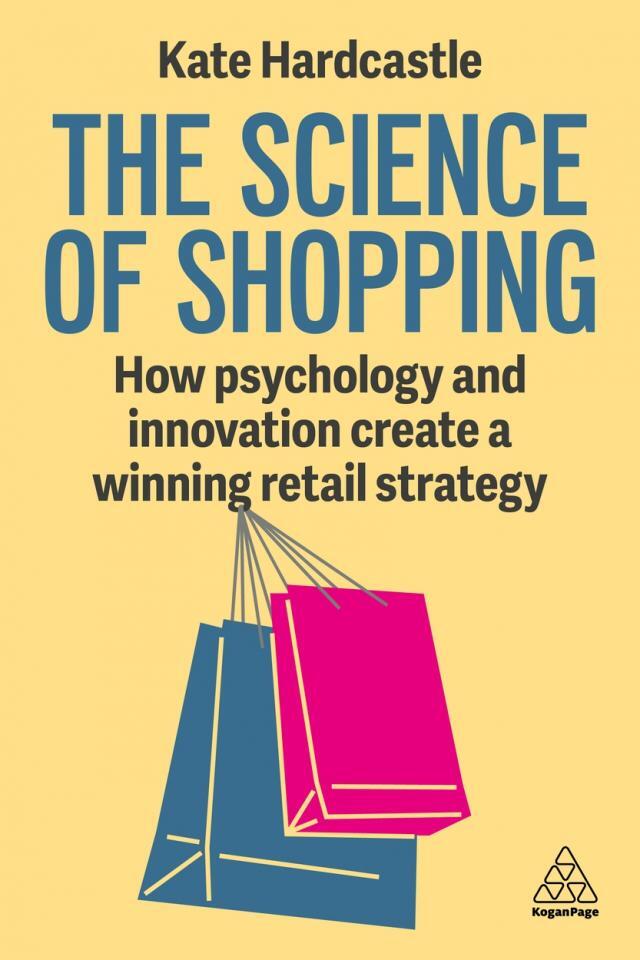 | Kate Hardcastle MBE: Hi, I’m Kate Hardcastle, the author of The Science of Shopping: How Psychology and Innovation Create a Winning Retail Strategy, published by Kogan Page. Drawing on nearly thirty years of experience working with brands such as Disney, Marks & Spencer, and American Express, I reveal how emotions, perceptions, and social factors influence consumer behavior in our evolving retail landscape. This book provides practical insights into everything from the psychology of pricing to creating immersive retail experiences that resonate with customers. You’ll discover real-world examples from leading companies and learn how to blend physical and digital elements to create memorable, value-driven shopping experiences. As an IN CLEAR FOCUS listener, you can save 25% on The Science of Shopping when you order directly from KoganPage.com. Just enter the exclusive promo code BIGEYE25 at checkout. Shipping is always complimentary for customers in the US and UK. I really hope my book helps you understand what motivates us as shoppers and how to develop effective retail strategies. Thank you! |
Adrian Tennant: Welcome back. I’m talking with Kate Hardcastle, a consumer insight expert and the author of the Bigeye Book Club selection for August, “The Science of Shopping.” Kate, you discuss the concept of retail spaces evolving places in your book. How are successful retailers adapting their physical environments to meet these changing consumer expectations?
Kate Hardcastle MBE: Yeah, there is more hybrid in there and I think we’re seeing that in many areas of business growth and development. I’m excited and delighted when brands want to create alliances and partnerships cross-sector, rather than just sticking to their own type. You know, a fashion retailer with a fashion designer is okay. Fashion retailer with a sports brand gets exciting. With an entertainment brand, it gets even more exciting. Where can this go? What could this look like? And ditto, I believe the same for those successful stores as hybrid spaces. So it’s a gallery to show off the product. It’s a service center, maybe, if it’s a certain product. And it’s maybe an event space or a meeting place. So it’s about the interactions. It’s about going beyond the transaction. I think if you kind of imagine an Apple Genius bar meeting a Sephora makeup counter service area, then adding in a bit of Disney theme park in there, and then some food and beverage or some entertainment to go with it. And it’s exactly the reason that we’re seeing a mall where you will have an escape room next to a fashion retail store, because it’s not the case that we have to have lines of cookie-cutter retail now, and “I’ll go down this avenue in the mall because I’m this type of product” and “I’ll sit in this avenue in the mall because we offer different products.” You know, it’s about creating space in which we live and not to shop. And then that space in which we live and have services and products served to us, how we can self-curate that so it feels good. So it’s all exciting for me. It’s about adaption beyond shelves of stuff to those retail stages of experience.
Adrian Tennant: We’ve talked a little bit about the digital transformation of retail. I’m curious, Kate, what role do you see technologies like artificial intelligence and augmented reality playing in creating more engaging shopping experiences?
Kate Hardcastle MBE: Well, I’m certainly not fearful of it, Adrian, let’s put it that way. I’ve been fortunate enough that I was brought quite a broken computer at 13-years-old to play with and interact with, and was coding at a young age. And I’ve always felt tech can be part of this. What I’m seeing is that tech is able to do a lot of the heavy-lifting. And that’s the right place, I think. It needs to be that humans are creating human experiences, opportunities. There is a depth to our knowledge that we just understand. Seventy percent of our communication is body language. So, I’m so grateful the cameras are on for this. I can see you and I’m interacting with you in one way, but I’m making sure that our listeners who can only hear us, can really engage with my voice, with the inflections and the way I’m getting excited about something, or actually I’m really quite concerned about something. You know, a lot of that is a sophistication of human-to-human interaction. So we could have a sparking imagination before buying. We can have visualization of retail spaces and real spaces, but then also imaginary spaces to bring excitement. But tech alone is not going to be enough. It’s that emotional intelligence we need as the overlay and the director. So treat the human as the true north and the technology as the enablers.
Adrian Tennant: Hmm, got it. Pricing psychology plays a significant role in consumer behavior. Kate, what are some of the key psychological pricing strategies that brands should understand?
Kate Hardcastle MBE: Yes. And it still works just to this day. One of the pushbacks I get at this point is, “Oh, come on, people are so savvy now. Does the pricing strategy piece still work?” Absolutely. So there are traditional techniques like anchoring, which is where we show that kind of higher price first to get used to an item at that price point. And then any evolvement from that feels like value. There’s charm pricing. So instead of a $10 – $9.50 or $9.99, just a lower amount, actually because it starts with a 9 rather than a 10. That’s just a signal to say, “Yes, that’s more affordable now.” Higher prices might create the notion of a perceived quality that might be there or might not necessarily be there. So it’s not just about math. It’s about messaging. And we’ve used psychology strategies very effectively over the years. But as the consumer gets more sophisticated, then we have to play with that some more. We’re getting a lot of information coming back from the data that helps us understand very quickly almost that mind map of routes and we can trial things very quickly. I was speaking to some retailers the other day that were just showing a slight difference of just a color on a price that draws attention to it that can really make a difference. Success rates being plus 30 percent on slight tonal difference on a price color, but just to put a bit of real life in there. So I’ve always been interested in meddling in antiques and that kind of thing. It’s just been a beloved passion of mine and I sell and I have a little store account to do this and I still play with price dynamics there and it still works. Even last night, Adrian, I can promise you, I was messing with some prices and saw a very different impact by just using some of these techniques. So it’s very effective still.
Adrian Tennant:Now, as someone who’s worked with major global brands, what’s the biggest mistake you see companies making in their approach to consumer engagement?
Kate Hardcastle MBE:Incredible question. Very nuanced business-to-business, and certainly down to the people in the business. Are there traditional retailers at heart or traditional finance people or property people at heart, which will direct them in different ways? If I had to give an overall takeout, I would say there’s something about “we have two ears and one mouth and we should use in that order!” So I think there’s a listening issue going on. And I don’t think that’s just with the consumer. I think that can be internal department to department and different bigger organizations too. Communication’s key, but I do think that’s translated as “talk more, send more emails, be more present, talk on social platforms more.” True helps. But to me, my biggest, most successful breakthrough has been listening. And a big example, and I can’t mention the brand for this, was when a lot of money had been spent on research pieces and data analytics to understand consumer mindset on a very big launch. And something really had been missed in the overlay of the emotional intelligence of what was being asked and how the consumers were answering it. And only with my involvement was I able to go in and say, “Well, of course the answers are going to come out this way, but if we asked and sent the question a different way, if we just did some qualitative pieces as well as quantitative and just added in that layer of emotional insight, I think they’re going to answer a different way.” They absolutely did. They absolutely changed their minds. It was a complete 180, and thankfully, the project was saved before it was doomed to fail from its inception. So I truly think listening – which I’m not doing a very good job of in a podcast, I appreciate, but generally! – listening, as I listen to others, as I bring other expertise in the room, that’s my greatest skill and it’s the greatest gift I can offer as an answer to those people listening to this thinking, how can I evolve and adapt?
Adrian Tennant: What’s the most important takeaway you want readers to implement after reading “The Science of Shopping”?
Kate Hardcastle MBE: It sounds basic, but it’s incredibly difficult to do. When I go into organizations now, to the point that they talk about the customer versus 20, 30 years ago, it’s a different playing field. And a phrase I don’t particularly like – I’m going to be honest and controversial here – is I hear a lot of organizations telling me they’re “customer-obsessed.” I don’t particularly want an organization to be obsessed with me as a consumer, but I understand what they’re trying to say. I’m not being pedantic. I get, they’re trying to say to me, there is nothing more important. And that’s quite true. But I think a lot of organizations think they’ve got customer right at the heart, right at the center, and they don’t. They might have techniques and data that tell them that they’re doing things and shifting things around that. But to build trust takes time. Think about it in a normal relationship in your life, be it with a friend or a relation, or your partner. That is a big old day-by-day, “take your time.” I’ve been married for over 20 years. I’m still working on this, right? We’re still working on it and it will fluctuate and we have ups and we have downs, like every person in a relationship. You can’t take it for granted. You can’t say “We did all the metrics and data on customer insight. We’re really clear now. Thanks very much. On we go for the next year.” It’s so frangible. It’s so shape-shifting that you need a way of saying, “Look, we are almost permanently involved with this.” It’s evolutionary. It’s evolving. It doesn’t stop. It is a way to build that trust, embrace the purpose, never underestimating just how much emotion, even in the most basic of purchases, fits in. And finding a way to keep coming back to that on a daily, weekly, monthly basis, rather than “We’ve got the data now, we’ve had the big four consultant come in, we’ve got the clarity. We’re just on this now,” because that can pull away very, very quickly. And also down then to the interpretation of many different individuals to deliver it. And I think that, again, is where things can come unstuck very quickly. So for me, great that you might have customer at the heart. What are you doing to keep them at the heart? What are you doing to understand the heartbeat? What are you doing to make sure that when that changes, you’ve got methods in place to keep up to it?
Adrian Tennant: Kate, as a shopper, what makes you happy?
Kate Hardcastle MBE: What makes me happy when I shop? Real people really matter to me still. I’m so sensitive to body language. I hate, for instance, when I check in at hotels, that people say to me, “ID and credit card,” before they’ve said “Hello” to me. So, please say “Hello” to me. Please say “Hi!” Please give me a smile. It means the world.
Adrian Tennant: Great conversation. Kate, if listeners would like to learn more about your consulting, your work at Insight with Passion, your book, “The Science of Shopping,” or connect with you, what are the best ways to do so?
Kate Hardcastle MBE:It’s been great to speak to you. You’re very welcome to contact me. Kate Hardcastle in Google normally will serve up many options, but I am on Instagram @RealKateHardcastle, LinkedIn at Kate Hardcastle, and the organization and the website that can direct you is katehardcastle.com.
Adrian Tennant: Perfect. And just a reminder that IN CLEAR FOCUS listeners can save 25 percent on Kate’s book, “The Science of Shopping,” when you order directly from KoganPage.com using the promo code BIGEYE25 at checkout. Kate, thank you very much for being our guest this week on IN CLEAR FOCUS.
Kate Hardcastle MBE:Thank you so much for having me. It’s been a joy.
Adrian Tennant:Thanks again to my guest this week, Kate Hardcastle, consumer insight expert and author of “The Science of Shopping.” As always, you’ll find a complete transcript of our conversation with timestamps and links to the resources we discussed on the IN CLEAR FOCUS page at Bigeyeagency.com, just select ‘Insights’ from the menu. Thank you for listening to IN CLEAR FOCUS, produced by Bigeye. I’ve been your host, Adrian Tennant. Until next week, goodbye.
TIMESTAMPS
00:00: The Rebirth of Retail
00:18: Introduction to IN CLEAR FOCUS
00:39: The Multi-Sensory Shopping Experience
01:34: Introducing Kate Hardcastle
02:46: Inspiration Behind “The Science of Shopping”
04:18: Understanding the Bio-Hierarchy of Needs
06:00: Emotional and Social Drivers in Shopping
08:32: Impact of Digital Transformation on Retail
10:44: Personalization in Modern Retail
13:05: The Role of Brick-and-Mortar Stores
15:14: Retail as Theatre
17:35: Evolving Retail Spaces
21:08: Technology’s Role in Shopping Experiences
22:35: Psychological Pricing Strategies
24:19: Common Mistakes in Consumer Engagement
26:41: Key Takeaways from “The Science of Shopping”
29:01: What Makes Kate Happy as a Shopper
29:34: Connecting with Kate Hardcastle
30:15: Closing Remarks
